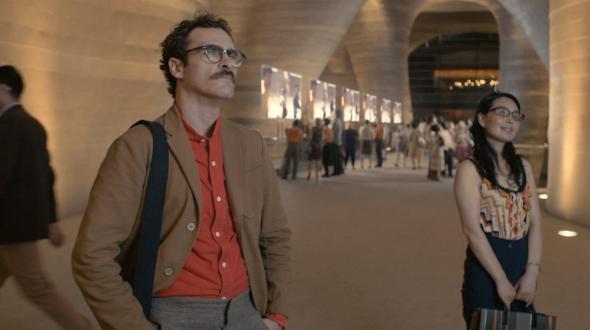Spike Jonze began production on Her in 2012, but in some ways he has been working on the movie for more than a decade. While the sci-fi romance is singular as a feature (and has been praised to the heavens, with New York’s David Edelstein calling it “the best film in years”), its unusual setting—call it the uncanny valley—is not new territory for Jonze: He has been exploring it for years in all his best shorts, such as the Ikea commercial Lamp (2002) and the 30-minute film I’m Here (2010).
Those shorts now feel like rehearsals for Her, and they are among the best places to gather insight into Jonze’s work. After all, while Her is his fourth feature, it’s the first based on his own original screenplay. (Being John Malkovich and Adaptation were written by Charlie Kaufman; Jonze and Dave Eggers adapted Where the Wild Things Are from the book by Maurice Sendak.) For fans interested in how Jonze came up with something as strange and beguiling as Her, Jonze’s shorts are the starting point. Below you will find a survey of all of Jonze’s fiction shorts, and what they can tell us about his new movie.
How They Get There (1997)
This entertaining but slight one-joke short, Jonze’s first, is too brief to reveal a whole lot about Jonze, but it’s already recognizable as his work: It’s set around L.A., it features a blend of music video and narrative styles, and it’s a romance about a man who, after meeting a woman, is drawn out of his shell. As in many of Jonze’s movies, the romance also leads to doom—often in the form of physical injury—for the man.
Lamp (2002)
Lamp was produced as a commercial, not a short film, but I’m including it here because it’s Jonze’s most acclaimed ad, because it’s the one most similar to Her, and because it plays like a 60-second short film. Like Her, Lamp takes an inanimate object as its title character: A woman tosses away her old desk lamp, and, as it sits alone on the curb, we slowly begin to sympathize with it. Then (spoiler alert) a man tells us that we’re crazy: The lamp “has no feelings,” he says, “and the new one is much better.”
This ambivalence toward consumer culture is a recurring theme in Jonze’s films (it’s one of the main subjects of Her). You can see it, for example, in his acclaimed GAP ad (which involves gleefully destroying a GAP store) and in his “Sun-Fizz” commercial (actually an ad for Sprite), which draws on the idea of subvertising. The brand mascot in the latter—a CGI character that looks at once cuddly and menacing—also brings to mind the giggly, foul-mouthed video game character from Her. Cuddly and menacing is a combination Jonze has returned to again and again.
We Were Once a Fairytale (2009)
This puzzling short—the result of a collaboration between Jonze and Kanye West—is about another lonely L.A. man, and again features a character who combines the cuddly and the menacing. (At the end, the man encounters a small, furry, stop-motion creature, who then commits seppuku.) The man, in this case, just happens to be Kanye West.
In the end the short is probably meant to say more about West than Jonze. Made during a dark period in West’s life—while he was recovering from the 2007 death of his mother and his 2008 breakup with his onetime fiancée—it’s a dark, twisted fantasy about feeling lost in the world, and about the difficulty of moving on. But these themes aren’t exactly out of place in Jonze’s oeuvre.
I’m Here (2010)
As Mark Harris wrote in a recent profile of Jonze, I’m Here “feels in many ways like a warm-up for his new movie.” The main difference: In this sci-fi romance, both of the lovers are artificially intelligent.
And while the short’s male protagonist, played by Andrew Garfield, happens to be a robot, things go much the same for him as for many Jonze protagonists: He’s a lonely (robo-)man in Los Angeles, and then his manic pixie dream robot takes him out of his shell. And this leads him into all sorts of emotional and physical danger (he literally loses an arm and a leg). As with Her, people will disagree about whether I’m Here has a sad or happy ending.
Mourir auprès de toi (2011)
Mourir auprès de toi, or To Die by Your Side, is another love story between what are essentially inanimate objects: in this case, the illustrations from two book covers. It also, once again, mixes the cutesy with the dark and the seemingly tragic—the romance forces both protagonists through a series of horrifying injuries.
This time, at least, there’s a more upbeat ending. And Mourir shares one last thing with Her: As in his new feature, Jonze doesn’t let the lack of living flesh stop his protagonists from going all the way.
